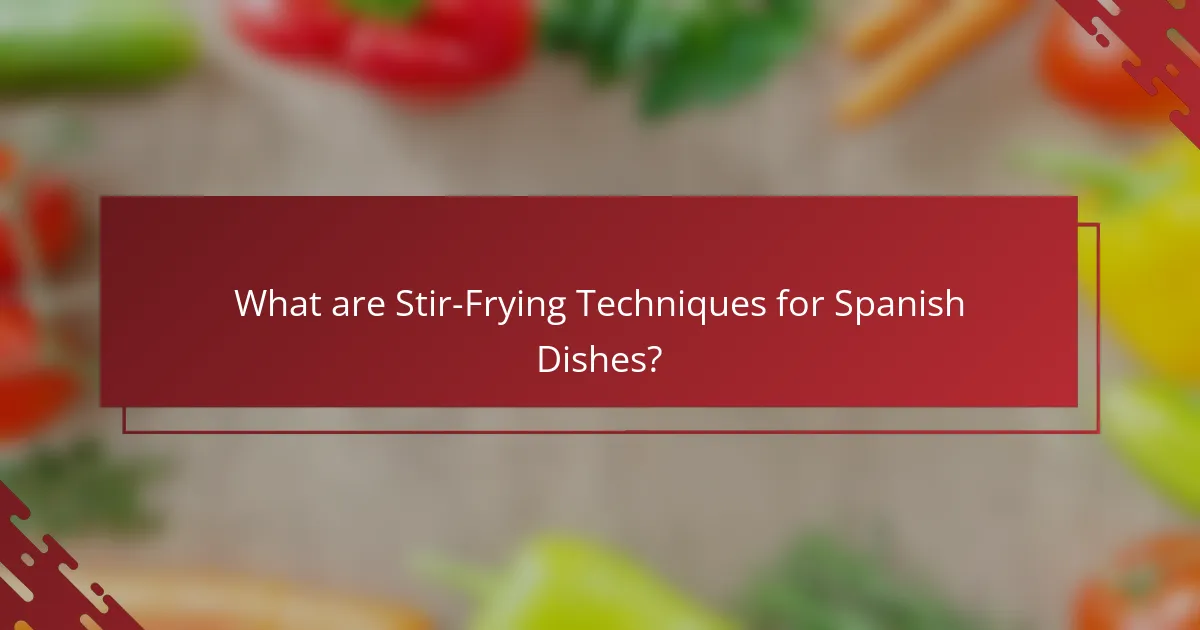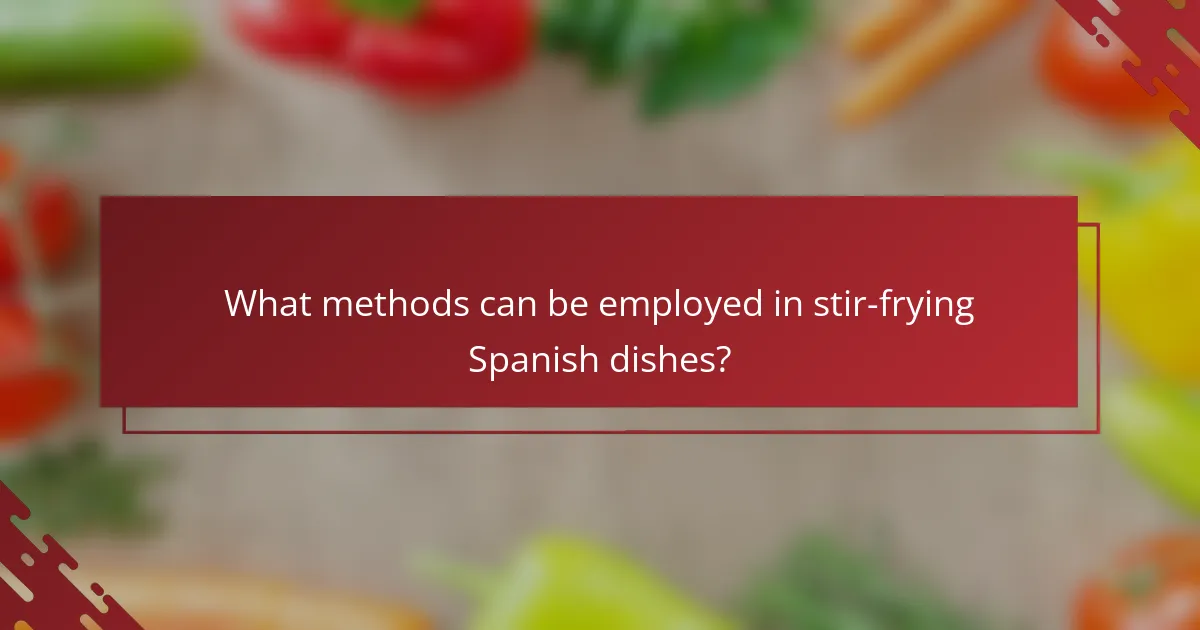Stir-frying is a high-heat cooking technique that is effectively applied to traditional Spanish dishes, utilizing a wok or large skillet to achieve quick and flavorful results. Key methods include preheating the pan, using uniform ingredient sizes for even cooking, and incorporating essential Spanish ingredients such as chorizo, bell peppers, and onions. The use of olive oil and other high smoke point oils enhances flavor while maintaining health benefits. Continuous stirring is crucial to prevent burning, and spices like smoked paprika and saffron can be added towards the end for maximum flavor impact. This approach preserves the vibrant colors and textures characteristic of Spanish cuisine.

What are Stir-Frying Techniques for Spanish Dishes?
Stir-frying techniques for Spanish dishes involve high-heat cooking and quick preparation. This method often utilizes a wok or a large skillet. Key techniques include preheating the pan to achieve a sear. Ingredients should be cut into uniform sizes for even cooking. Common Spanish ingredients include bell peppers, onions, and chorizo. The use of olive oil is prevalent for flavor and health benefits. Stir-frying typically requires continuous stirring to prevent burning. This technique allows for the preservation of vibrant colors and textures in the dish. Traditional Spanish flavors can be enhanced with spices like paprika and saffron during the stir-fry process.
How does stir-frying differ from other cooking methods in Spanish cuisine?
Stir-frying in Spanish cuisine differs from other cooking methods primarily in its speed and technique. This method involves cooking food quickly at high heat while stirring continuously. Unlike traditional methods such as simmering or roasting, which take longer and often involve lower temperatures, stir-frying retains the food’s texture and color. Ingredients are typically cut into small, uniform pieces to ensure even cooking. This method allows for the preservation of nutrients, as the cooking time is significantly reduced. Additionally, stir-frying often utilizes a small amount of oil, contrasting with methods that may require more fat. The distinctive flavors in stir-frying come from the quick incorporation of spices and sauces, which contrasts with the deeper, slower flavors developed in braising or stewing.
What are the key characteristics of stir-frying in Spanish dishes?
Stir-frying in Spanish dishes is characterized by high heat, quick cooking, and the use of a wok or large skillet. This technique allows for the preservation of flavors and textures of the ingredients. Common ingredients include vegetables, meats, and spices, which are often cut into small, uniform pieces. Olive oil is typically used as the cooking fat, enhancing the dish’s flavor. The method emphasizes vibrant colors and fresh ingredients, aligning with the Mediterranean diet. Spanish stir-frying often incorporates traditional seasonings like garlic and paprika, contributing to its distinctive taste. This cooking style is efficient, making it suitable for busy kitchens while still delivering authentic Spanish flavors.
Why is stir-frying a preferred method for certain Spanish recipes?
Stir-frying is preferred for certain Spanish recipes due to its ability to quickly cook ingredients while retaining their flavor and texture. This method allows for high heat cooking, which enhances the natural tastes of vegetables and proteins. Ingredients are typically cut into small, uniform pieces for even cooking. The quick cooking time minimizes nutrient loss, preserving the health benefits of vegetables. Spanish dishes often include vibrant vegetables like bell peppers and onions, which benefit from this cooking technique. Additionally, stir-frying allows for the use of various oils, enhancing the dish’s flavor profile. This method is especially effective for recipes that require a balance of crispy and tender textures.
What are the essential ingredients for stir-frying Spanish dishes?
Essential ingredients for stir-frying Spanish dishes include olive oil, garlic, onions, bell peppers, and various proteins like chicken or seafood. Olive oil is a staple in Spanish cuisine, providing flavor and a high smoke point for stir-frying. Garlic and onions add aromatic depth to the dish. Bell peppers contribute sweetness and color. Proteins such as chicken, shrimp, or chorizo are often used for substance. Additionally, spices like paprika enhance the traditional Spanish flavor profile. These ingredients are commonly found in many Spanish recipes, showcasing their importance in stir-frying techniques.
Which vegetables are commonly used in stir-fried Spanish cuisine?
Common vegetables used in stir-fried Spanish cuisine include bell peppers, onions, and zucchini. Bell peppers add sweetness and color to dishes. Onions provide a strong flavor base. Zucchini contributes a mild taste and tender texture. Other vegetables like garlic, eggplant, and green beans are also frequently included. These ingredients are often combined to create vibrant and flavorful stir-fry dishes. The use of these vegetables reflects traditional Spanish flavors and cooking techniques.
What proteins work best for stir-frying in Spanish dishes?
Chicken, pork, and shrimp are the proteins that work best for stir-frying in Spanish dishes. Chicken is commonly used due to its versatility and ability to absorb flavors. Pork provides a rich taste and pairs well with spices typical in Spanish cuisine. Shrimp adds a seafood element that complements many traditional Spanish ingredients. These proteins are often marinated to enhance their flavor before stir-frying. Popular Spanish dishes like paella and fideuà showcase these proteins effectively. Their quick cooking time makes them ideal for stir-frying techniques.
How do spices and seasonings enhance stir-fried Spanish recipes?
Spices and seasonings significantly enhance stir-fried Spanish recipes by adding depth and complexity to flavors. Common spices like paprika and saffron contribute distinctive tastes. Paprika provides a smoky richness, while saffron adds a unique floral note. Seasonings such as garlic and onion create a savory foundation. These ingredients elevate the overall dish, making it more aromatic and appealing. Research indicates that the right combination of spices can enhance the sensory experience of food. A study published in the Journal of Culinary Science and Technology notes that spices influence taste perception and enjoyment. Thus, spices and seasonings are essential for creating authentic and flavorful stir-fried Spanish dishes.

What methods can be employed in stir-frying Spanish dishes?
Stir-frying Spanish dishes can be effectively achieved using high-heat techniques. The methods include using a wok or a large skillet for even cooking. Ingredients should be prepped in uniform sizes for consistent cooking. Quick cooking ensures the preservation of flavors and textures. Utilizing oil with a high smoke point is essential for optimal results. Common oils include olive oil or sunflower oil. Adding aromatics like garlic and onion at the start enhances flavor. Stir-frying in batches prevents overcrowding and ensures even heat distribution. These methods align with traditional Spanish cooking practices, allowing for vibrant and flavorful dishes.
How do you prepare ingredients for stir-frying Spanish dishes?
To prepare ingredients for stir-frying Spanish dishes, start by selecting fresh vegetables and proteins. Common vegetables include bell peppers, onions, and zucchini. Cut these vegetables into uniform pieces for even cooking. Proteins such as chicken, shrimp, or chorizo should be sliced into bite-sized pieces.
Marinating proteins enhances flavor; use olive oil, garlic, and spices like paprika. Preheat the stir-fry pan or wok to a high temperature for optimal cooking. Add oil to the pan before incorporating the ingredients. Stir-fry in small batches to avoid overcrowding, which ensures even cooking.
Spanish dishes often include ingredients like saffron or smoked paprika, which should be added towards the end to preserve their flavors. This method maintains the vibrant colors and textures of the ingredients.
What cutting techniques are important for even cooking?
Uniform cutting techniques are crucial for even cooking. Techniques such as julienne, dice, and chiffonade ensure consistent size. Uniform pieces cook at the same rate. For example, diced vegetables can blend well in stir-frying. Julienne cuts provide quick cooking for thin strips. Chiffonade offers even cooking for leafy greens. Consistency in size helps avoid undercooked or burnt pieces. Proper cutting enhances the overall dish quality.
How does ingredient size affect cooking time in stir-frying?
Ingredient size significantly affects cooking time in stir-frying. Smaller pieces of ingredients cook faster due to increased surface area exposure to heat. For example, diced vegetables will soften in 3-5 minutes, while larger chunks may take 7-10 minutes. Uniformly sized ingredients ensure even cooking, preventing some pieces from being undercooked while others are overcooked. The heat in stir-frying is intense and quick, making size a crucial factor. Studies show that ingredient size can alter cooking efficiency, impacting texture and flavor development. Thus, cutting ingredients into smaller, uniform sizes optimizes cooking time and enhances the overall dish quality.
What are the different stir-frying techniques used in Spanish cooking?
Spanish cooking primarily employs techniques such as “salteado” and “fritura.” Salteado involves quickly cooking ingredients in a small amount of oil over high heat. This method retains the flavors and nutrients of the ingredients. Fritura refers to frying, where food is submerged in oil until crispy. It is often used for dishes like “pimientos de padrón” and “calamares.” Both techniques emphasize fresh ingredients and quick cooking times. These methods are integral to traditional Spanish cuisine, enhancing the taste and texture of various dishes.
How does the choice of oil impact the flavor of stir-fried dishes?
The choice of oil significantly impacts the flavor of stir-fried dishes. Different oils have distinct flavor profiles. For example, olive oil offers a fruity and peppery taste, enhancing Mediterranean flavors. In contrast, sesame oil provides a nutty flavor, ideal for Asian-inspired stir-fries. The smoke point of the oil also affects cooking. Oils with high smoke points, like canola or peanut oil, are suitable for high-heat cooking. This prevents burning and preserves the intended flavors. Additionally, the oil’s aroma contributes to the overall sensory experience of the dish. Thus, selecting the right oil is crucial for achieving the desired flavor in stir-fried dishes.
What are the steps to achieve the perfect stir-fry texture?
To achieve the perfect stir-fry texture, follow these steps. First, select fresh ingredients. Fresh vegetables and proteins retain moisture and crispness. Next, cut all ingredients uniformly. Consistent sizes ensure even cooking. Preheat your wok or pan thoroughly. A high temperature helps achieve the desired sear. Use a small amount of oil with a high smoke point. Oils like peanut or canola work best. Add ingredients in batches to avoid overcrowding. Overcrowding leads to steaming instead of frying. Stir continuously to promote even cooking. This technique enhances texture and flavor. Finally, remove from heat as soon as the ingredients are cooked. This prevents overcooking and maintains crispness.

What cooking tips can enhance your stir-frying experience with Spanish dishes?
Use high heat for stir-frying Spanish dishes to achieve a quick and flavorful result. This method allows ingredients to sear properly, enhancing their natural flavors. Preheat your wok or pan before adding oil to ensure even cooking. Use a combination of olive oil and a high smoke point oil for best results. Incorporate traditional Spanish ingredients like chorizo, bell peppers, and onions to maintain authenticity. Cut vegetables uniformly to ensure even cooking. Stir-fry in small batches to avoid overcrowding, which can lead to steaming instead of frying. Finally, add spices such as smoked paprika and saffron towards the end for maximum flavor impact.
How can you avoid common mistakes when stir-frying Spanish cuisine?
To avoid common mistakes when stir-frying Spanish cuisine, focus on proper ingredient preparation. Ensure all ingredients are chopped uniformly for even cooking. Use high-quality olive oil as the primary fat for authentic flavor. Preheat the wok or pan to a high temperature before adding ingredients. Stir-fry in small batches to maintain consistent heat. Avoid overcrowding the pan, as this leads to steaming instead of frying. Incorporate ingredients in the correct order, starting with proteins, followed by vegetables. Season gradually to enhance flavors without overpowering the dish. These practices help achieve the desired texture and taste characteristic of Spanish stir-fried dishes.
What temperature should you use for optimal stir-frying results?
Optimal stir-frying results are achieved at temperatures between 350°F and 450°F (175°C to 230°C). This high heat allows for quick cooking while preserving the texture and flavor of the ingredients. At these temperatures, the Maillard reaction occurs, enhancing the dish’s taste and aroma. Properly heated oil also prevents food from becoming soggy. Using a wok or a large skillet helps distribute heat evenly. Cooking in small batches maintains the temperature and ensures even cooking. This technique is essential for achieving the desired results in stir-frying Spanish dishes.
How can you ensure even cooking in a stir-fry?
To ensure even cooking in a stir-fry, cut ingredients into uniform sizes. This allows them to cook at the same rate. Use high heat to quickly sear the ingredients. Stir frequently to promote even exposure to heat. Add ingredients in stages, starting with those that take longer to cook. For example, add denser vegetables first, followed by softer ones. Use a wok or a large skillet for better heat distribution. These methods help achieve a consistent texture and flavor throughout the dish.
What are some best practices for stir-frying Spanish dishes at home?
Use high heat for stir-frying Spanish dishes to achieve optimal flavor and texture. Preheat your wok or skillet before adding oil. Choose oils with high smoke points, like olive oil or sunflower oil. Cut ingredients into uniform sizes for even cooking. Add aromatics like garlic and onion first for enhanced flavor. Introduce proteins and vegetables in stages based on cooking times. Stir frequently to prevent sticking and ensure even cooking. Keep ingredients dry to avoid steaming instead of frying. These practices help create authentic and delicious Spanish stir-fried meals.
How can meal prep improve your stir-frying efficiency?
Meal prep can significantly improve your stir-frying efficiency by streamlining ingredient preparation. Pre-chopping vegetables and proteins allows for quicker assembly during cooking. This reduces the time spent on prep work while ensuring all ingredients are ready to go. Additionally, having pre-measured sauces and seasonings helps maintain consistent flavor profiles. Studies show that organized meal prep can cut cooking time by up to 30%. This efficiency allows for faster meal turnaround, making it easier to enjoy home-cooked Spanish dishes on busy days.
What tools and equipment are essential for successful stir-frying?
A wok is essential for successful stir-frying. It provides a wide, curved surface that allows for even heat distribution. A high heat source, such as a gas burner, is also crucial. It delivers the necessary temperature for quick cooking. A spatula or wooden spoon is needed for stirring and flipping ingredients. These tools help prevent food from sticking and ensure even cooking. A lid can be useful for steaming ingredients briefly. A heat-resistant glove protects hands from high temperatures. Finally, a cutting board and sharp knife are necessary for preparing ingredients. These tools collectively enhance the stir-frying process and improve results.
Stir-frying techniques for Spanish dishes focus on high-heat cooking methods that preserve the vibrant flavors and textures of ingredients such as bell peppers, onions, and various proteins. Key characteristics include the use of a wok or large skillet, uniform cutting for even cooking, and the incorporation of traditional spices like paprika and saffron. This article covers essential ingredients, common vegetables and proteins, and cooking tips to achieve optimal stir-fry results, as well as differences between stir-frying and other Spanish cooking methods. By utilizing proper techniques and tools, home cooks can efficiently prepare authentic Spanish stir-fried meals.